We have experience with new, existing and refurbished projects:
Evaluate
Water
Habitat
Climate
Fish Population
Fish
Stocking
Reproduction
Forage Fish
Trophy Fish
Management
Aeration
Feeds and Feeding
Water Quality and Enzymes
Progress Monitoring
Next steps to receive a free stocking quote:
1. We have the online free stocking plan (fill out information below) or:
2. Custom plan: Fill out the form below and add a note to the additional information “Interested in a custom plan”. Our staff will then send a detailed proposal regarding your custom plan.
3. You will receive a proposal via email that explain further what is included in the evaluation.
IMPORTANT: To receive fish, buyer must abide by the California Department of Fish and Wildlife stocking regulations and have an active stocking permit, if applicable.
The Professional Aquaculture Services (PAS) experienced staff has been helping private and public lake owners with stocking programs and lake management services for over 40 years. We are based in California and service ponds and lakes throughout the nation. In addition to lake and pond stocking, we have the ability to ship fish to any location for smaller fish stocking needs, including hobbyist and aquaponics projects.
Our Fish
Professional Aquaculture Services specializes in the production of bluegill, channel catfish, striped bass, largemouth bass, and white sturgeon for distribution to a variety of markets both domestically and internationally. This includes stocks for other fish farms, fish for the live fish markets, fingerlings and catchable size fish for recreational fishing lakes, and newly hatched fish for a growing market to fish farms in other countries.
Bluegill
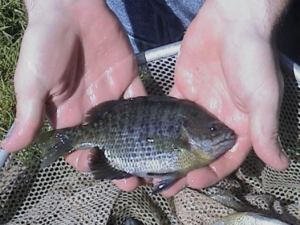
The bluegill is a deep, slab-sided sunfish with a rather small mouth. Males in breeding colors often have a deep red, almost dark brown breast. The side usually display vertical bars, but these are more prominent in smaller fish. The gill covers and chin are bright blue, giving the bluegill its name.
Growth of bluegill varies widely with population density. High population density retards growth while the opposite occurs with low density. Bluegill will reach 1 to 2 inches in length on the average in their first year of life. Bluegills mature during the second year under suitable conditions, but slower growth will delay maturity to the third year. Bluegill attain a length of up to 12 inches and weigh up to 2 pounds, but most bluegill caught by anglers seldom exceed 8 inches. The very popular and beautiful bluegill is also known as a sunperch, blue sunfish, copperbelly, copperhead, coppernose bream, redbreasted sunfish, yellowbelly, bluemouth sunfish, baldface, plumb granny, pumpkinseed, pond perch.
Channel Catfish
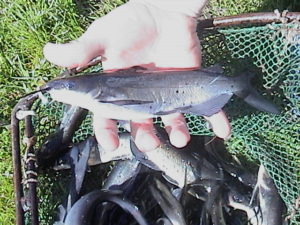
Channel catfish have been cultured by Professional Aquaculture Services (PAS) for over 22 years. PAS has developed a strain of channel catfish that demonstrates rapid growth and disease resistance. The stocks have been found clear of all major pathogens including channel catfish virus and E.S.C. Fish from the Chico strain are used throughout the world to establish disease free brood stock populations. These fish are also used as control fish for viral and bacterial work by researchers.
Fathead Minnows
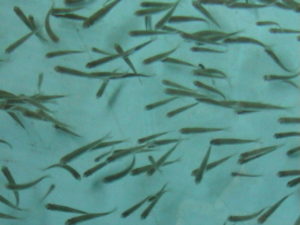
Fathead minnows are the ideal forage fish because adult fathead minnows are still small enough to be eaten by any predator fish. Fathead minnows are often stocked in new or less established ponds and lakes as the primary forage fish, before or simultaneously stocking the waters with a typical largemouth bass, bluegill, or channel catfish combination. Although any of these fish, bass, bluegill, or catfish does well on its own, minnow stocking helps get the fish population off to a good, strong start, providing any new or growing predator fish with an immediate and plentiful food source.
Largemouth Bass
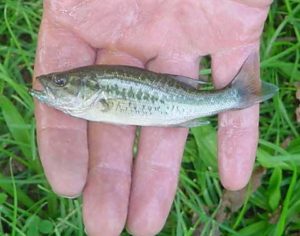
Largemouth bass has been cultured for private and public lake stocking. This has been done in extensive ponds. Professional Aquaculture Services is moving into the intensive cultivation of this fish for sale to other fish farms and to raise for the live urban fish market. Research has been ongoing in the formulation of diet and feeding practices for many years. We now feel that the time is right to put this information to work.
Mosquito Fish
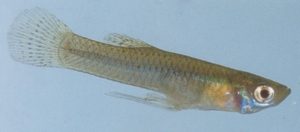
Mosquito fish are commonly known for their use as an easy mosquito combatant. They are live-bearing and produce three to four broods per year. The food of mosquito fish consists chiefly of small animals such as crustaceans and insects, but diatoms and algae are also eaten. The species feeds at the surface and invades water only a few inches deep, thereby permitting the fish to prey effectively on mosquito wrigglers. The life span is from about six to fifteen months. This fish has been stocked throughout the world for mosquito control, particularly to combat malaria, and its appetite for mosquito larvae is well known.
Sacramento Blackfish
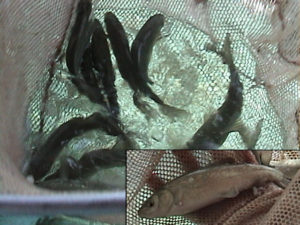
The Sacramento blackfish is a large, dark minnow with an upturned mouth. It is nearly round in cross section and has a conically-shaped head. It has small, fine scales. It grows to a length of two feet. The pharyngeal teeth are very long, and nearly straight.
It is found in the large natural lakes of central California, such as Clear Lake, and the lower slough-like reaches of the Sacramento and San Joaquin rivers and their associated drainages. It does not move into the swifter portions of the tributaries or into the foothill reaches of the rivers.
The blackfish reached its greatest abundance in the marshy, overflow areas, like Tulare Lake. It has been introduced into southern California. Like the carp, it spawns in shallows and is a prolific egg producer. A 17-inch female contained an estimated 350,000 eggs. The growth rate is rapid. In Clear Lake, blackfish range from 2.5 to 6.5 inches in length at the end of their first growing season. It feeds on plankton and bottom materials. The blackfish is of minor commercial importance, with over 100,000 pounds harvested in 1962. Fish are trucked alive to fish markets in Oriental districts, where the buyers select fish and carry them home alive. The young of this species are eaten by game fishes.
White Sturgeon
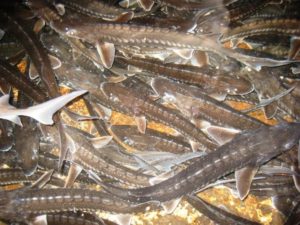
White sturgeon have been an integral part of fisheries research and development at Professional Aquaculture Services (PAS). Mr. Vaught was involved in the development of the first domestic white sturgeon brood stock. Together with researchers for the University of California at Davis, Mr. Vaught and other growers cooperated to move the culture of white sturgeon from a research and development species to full production in less than eight years. PAS now provides fingerling sturgeon to other growers and provides fish to recreational lakes.
General Considerations and Assumptions
The recommended pond stocking and lake stocking rates will vary depending on the condition of the pond and the climate of the area. The amounts of fish recommended take into account fish that will be removed from the pond by predators. The size of fish is determined by factors such as existing fish, mode of transport to the pond and the amount the pond owner wants to invest in fish. If the pond has no existing fish it is advisable to stock larger numbers of small fish. This will allow the pond owner to invest as a lower price for fish, transport is less expensive and the fish can be stocked at the same size to minimize predation. If small numbers are stocked, these fish may grow to a large size which forces the pond owner to stock larger fish in subsequent years to avoid predation from the initial fish stocked.
